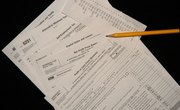Income from farming is never certain or even predictable. Weather, pests, market prices and other factors often make this type of business less than stable. In the meantime, as a farmer, you’ll face many expenses related to successfully running a farm. Luckily, the Internal Revenue Service treats farming like other businesses and allows you to deduct many of the bills that you pay for your farming business from the income that you make.
Farm Income Accounting Methods
The IRS generally recognizes two methods of accounting for farm income. You can choose to use the common cash method, which allows you to add all income earned in a tax year starting in January and ending in December. A second accrual method is an accounting choice mainly used by farming corporations and some tax shelter entities. This more flexible method lets you claim expenses and income in the tax year that applies, which might not be the same calendar year.
Farming Expenses Receipts
The IRS expects you to keep receipts for any farming expenses that you claim on your taxes. Of course, you or your tax preparer will use these receipts to determine if the expense is relevant to your farming business. Your expense records should also be logged in a common ledger or a computer spreadsheet weekly or monthly. You can record them by category of expense or simply track them by date.
IRS 1040 Schedule F Income
As a farmer, you’ll complete Schedule F Farming Profit and Loss as an attachment to your normal Form 1040. This form is a snapshot of both your farming income and your expenses.
When you use the cash method of accounting, you list all farm income in Section I of Schedule F. Show sales of livestock, if applicable, and the cost of livestock sales on Lines 1a and 1b and then calculate the difference on line 1c. List your total farm production income on line 2. Add any relevant income amounts from categories on lines 3 through line 8, then complete your gross income calculation on Line 9 of Section I.
Schedule F Section II Deductible Expenses
In Section II of Schedule F, the IRS lists many normal farming expenses, with the primary ones assigned to a specific line on this form. Use your expense records to calculate total applicable amounts on all lines for common expenses such as farm vehicles, seed, insurance, freight costs, fertilizer and supplies.
Use the IRS 2019 Instructions for Schedule F to review and calculate additional expenses such as depreciation, interest or leases. You might not have deductible expenses for every category, so you’ll only list amounts that apply to your farming business. Total your farm expenses on Line 33 in Section II.
Schedule F Line 32 Other Expenses
It’s a costly mistake to overlook other deductible expenses that you paid during the year to operate your farm. Lines 32a through 32f of Schedule F let you account for farming expenses that don’t fit the predetermined categories on the form. The University of Nebraska–Lincoln notes that you can deduct part of your costs for cell phone service, a home office, wages paid to your spouse or your children and potentially a portion of your mortgage costs.
The 2019 Instructions for Schedule F lists several other expenses that you might be able to list on Line 32. These include start-up costs, forestation, legal and accounting fees, certain tools, travel and meals, along with bad debts.
References
- Internal Revenue Service: 2020 Publication 225, Farmer's Tax Guide
- Internal Revenue Service: 2020 Schedule F (Form 1040)
- Internal Revenue Service: 2019 Instructions for Schedule F
- Internal Revenue Service. "Publication 225: Farmer's Tax Guide." Pages 1, 8. Accessed Feb. 13, 2020.
- Internal Revenue Service. "Publication 225: Farmer's Tax Guide." Pages 26. Accessed Feb. 13, 2020.
- Internal Revenue Service. "2019 Instructions for Form 1120." Page 2. Accessed Feb. 13, 2020.
- Internal Revenue Service. "Publication 225: Farmer's Tax Guide." Page 74. Accessed Feb. 13, 2020.
- Internal Revenue Service. "2019 Instructions for Schedule F." Page F-2. Accessed Feb. 13, 2020.
- Internal Revenue Service. "Publication 225: Farmer's Tax Guide." Page 5-7. Accessed Feb. 13, 2020.
- Internal Revenue Service. "Publication 225: Farmer's Tax Guide." Page 10-12. Accessed Feb. 13, 2020.
- Internal Revenue Service. "Publication 225: Farmer's Tax Guide." Page 18. Accessed Feb. 13, 2020.
- Internal Revenue Service. "Publication 225: Farmer's Tax Guide." Page 8. Accessed Feb. 13, 2020.
- Internal Revenue Service. "Publication 505: Tax Withholding and Estimated Tax." Page 25. Accessed Feb. 13, 2020.
- Internal Revenue Service. "2019 Instructions for Schedule F." Accessed Feb 13, 2020.
- Internal Revenue Service. "All Taxpayers Will File Using 2018 Form 1040; Forms 1040-A and 1040-EZ No Longer Available." Accessed Feb. 13, 2020.
Writer Bio
Carol Luther has published feature articles in print magazines, ghostwritten blogs, and produced digital content since 2007. She has published personal finance and small business articles for the Houston Chronicle, Mahalo, the Nest, USA Today, Wahm, and Zacks. Carol has designed, implemented and managed multi-year, multimillion-dollar domestic and international projects services for higher education, nonprofits, and small to medium businesses for more than 20 years.

